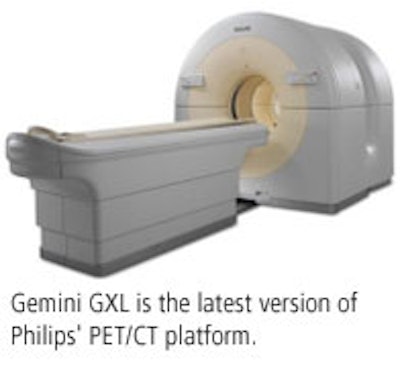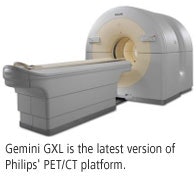
Philips Medical Systems of Andover, MA, will unveil its PET/CT viewer for the company's Extended Brilliance Workspace application, and will discuss its plans to move the Gemini GXL PET/CT scanner to Brilliance 2.0 workstation software.
The PET/CT viewer allows real-time slice-to-slice PET/CT display, enabling clinicians to optimize their diagnostic case review to meet specific clinical needs. This includes layout editing for individual review and fused displays, quantitative analysis tools for standardized uptake value (SUV) measurement, region of interest (ROI) generation, and comparison review for multiple instances of PET/CT imaging for a single patient. Users are also able to save and recall their customized image display layouts, the vendor said.

Included in the PET/CT viewer is GuidedFlow productivity, a feature for enhanced workflow efficiency, from diagnostic review to printing and reporting processes, Philips said.
In addition, the vendor is offering software applications that provide tools to aid in quantitative analysis of disease. These include Emory Cardiac Toolbox PETtools, which include perfusion and viability analysis of the myocardium with minimal operator interaction; comparative image slice review, stress/rest, or rubidium/rubidium-FDG imaging; comparison of perfusion to viability data; 3D image displays, coronary overlays, and gated 3D-cine displays; and quantitative gated cardiac review such as left ventricular ejection fraction and 2D/3D wall motion and wall thickening display.
A Heart Fusion application will also be displayed, according to the developer. This toolset is an extension of Emory Cardiac PETtools and features registration and overlay display of the 3D coronary artery tree from CT angiography (CTA) with a 3D perfusion map from PET. A 3D "Mask-at-Risk" display is also incorporated for correlation between coronary artery stenosis as seen with CTA and ischemic/infarcted myocardium as demonstrated with PET.
Philips will also be demonstrating its NeuroQ application, which automatically generates quantified analysis of regional cerebral activity from FDG-PET images. This provides the capability to generate comprehensive image presentations, as well as accurate quantification of relative activity in multiple brain regions and quantitative detection of clinically meaningful abnormalities in regional brain metabolism, Philips said.
The developer will be unveiling its integration strategy for its Brilliance 2.0 platform for the Gemini GXL PET/CT scanner. According to Philips, this move increases the commonality between the Brilliance CT and Gemini PET/CT product families. The migration strategy provides workflow enhancements, image quality improvements, and new dose-management capabilities, Philips said. The integrated platform will not be commercially available at the time of the RSNA show, the company said.
Rounding out Philips' molecular imaging offerings will be both the Gemini PET/CT and Precedence SPECT/CT lines, with 64-slice options based on the company's Brilliance CT scanner. These products were unveiled earlier this year at the Society of Nuclear Medicine meeting in Toronto.
By Jonathan S. Batchelor
AuntMinnie.com staff writer
November 3, 2005
Copyright © 2005 AuntMinnie.com




















